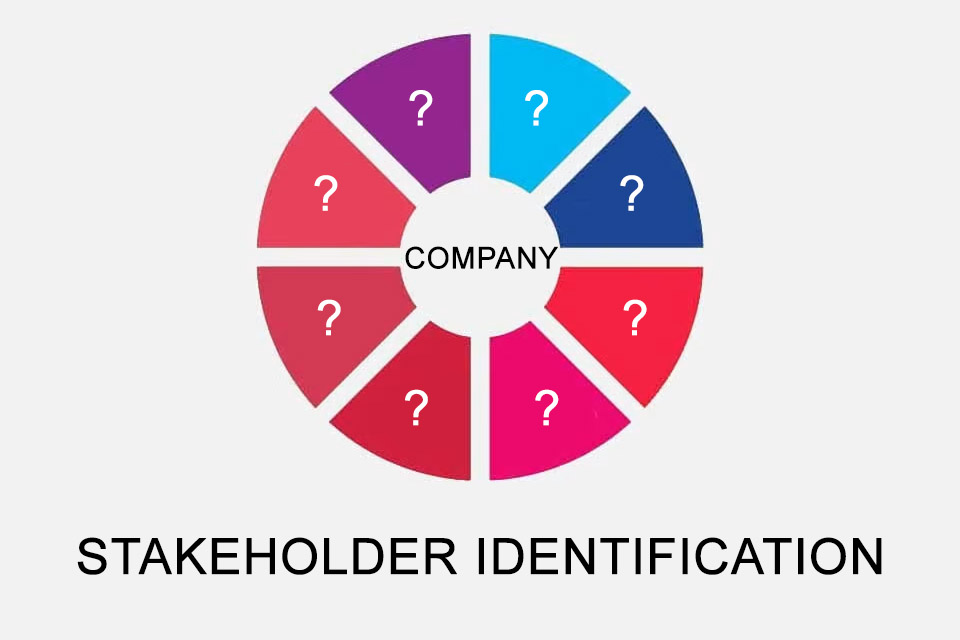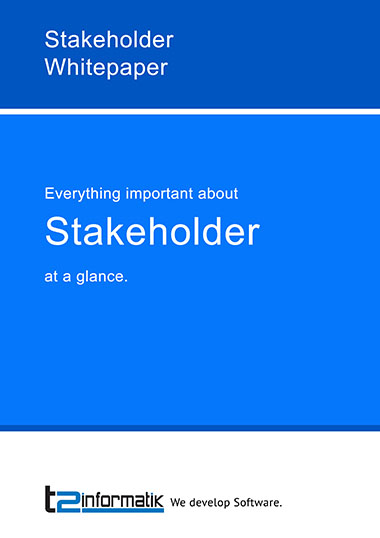What is Stakeholder Identification?
Smartpedia: Stakeholder identification determines all persons or organisations that are directly or indirectly affected by or have an interest in the activities of a company.
Stakeholder Identification Definition
Stakeholder identification is the first step in stakeholder management. Identifying, analysing and communicating – these are the three essential activities in dealing with stakeholders. Stakeholder identification therefore takes place before the stakeholder analysis. It aims to identify all organisations and individuals who are directly or indirectly affected by a company’s activities or who have a specific interest in these activities. The result should be a list of all stakeholders.
Questions on Stakeholder Identification
Especially at the beginning of a project or a development, the environment is relatively confusing. How do you find the stakeholders in such a situation, i.e. the people, groups and organisations who are directly or indirectly affected by your project? Four initial questions will help you structure the project environment and identify the key stakeholders:
- Who is affected by the project? When answering the questions, it is best to orient yourself first to internal and then external company structures. Which business areas are affected, which departments and which locations? Are there people affected who do not define themselves by such affiliation (e.g. employees of other projects or members of the works council)? And what about your customers, which organisational areas and employees are affected?
- Which processes are affected by the project? Also with this answer you should think first of internal and then of external processes, e.g. with partners.
- Which external groupings – besides the customers – are affected by the project? The answer to this question provides you with stakeholders from your market environment such as suppliers, associations or creditors.
- What are the parameters for the project? The question is aimed at legal, normative or regulatory requirements. You may have already identified some of the answers when defining the system context.
The Result of Stakeholder Identification
The result of stakeholder identification is a list of affected organisations and individuals:
| Organisation | Name of Stakeholders | Role |
| Our company Ltd | Martin Muller | Owner |
| Our supplier Ltd | Bettina Maize | Accountant |
As part of the stakeholder analysis, this list is enriched with further information such as goals, motives or the willingness to actively participate. It is important to note that both the list and the analysis represent a snapshot, i.e. it is advisable to question and update the results in the course of continuous stakeholder management.
The alternative way to stakeholder identification
Stakeholder Identification by Role
In the course of your stakeholder identification you can also deal with the possible roles of groups of people and persons who show interest in your company and your undertaking. Here you will find some abstract examples with possible motives:
- Who is your owner? Most owners pursue the goal of achieving a high return on sales and a capital gain. A social position and social aspects such as social responsibility are also conceivable motives.
- Who are your investors? The interest of the investors lies in a return on investment, i.e. they want to pay interest on their investment in the best possible way and at the same time as risk-free as possible.
- Who are your suppliers? Suppliers are companies or persons who develop or procure services, products or systems for a fee on behalf of their customers. Their economic success depends on the delivery or procurement, so they would like to establish long-term business relationships.
- Who are your customers and users? Each of us is a customer of one or the other company. Most customers want to buy high quality products at a reasonable price in order to satisfy their needs. In a way, users are also customers who do not, however, invest their own financial resources in the procurement of solutions, products or systems. Nevertheless, they usually also have high quality standards and also hope to satisfy their needs (e.g. safer, easier, more efficient work).
- Which employees are affected or interested? Employees are also often interested in new solutions, products or services. The interests themselves can vary greatly depending on the role. For example, a project manager would like to implement projects on time and within budget, a management team would like to realise sales, and the managing director would like to improve the company’s future security. Even “employees away from the project” may be interested in a new solution if they are to benefit from it, e.g. as users, and if they expect it to bring about changes. In addition, employees can also be investors.
- Which organisations are affected or interested? Organisations such as associations, trade unions or clubs pursue different goals depending on their purpose. The stakeholder analysis has to determine which goals and motives these are in detail.
- Which government authorities should be considered? The legislator is interested in compliance with laws and regulations. State authorities such as the Medicines Agency or the Federal Office of Consumer Protection and Food Safety ensure that these laws and regulations are implemented and complied with. For the lawmaker, the success of a company is not a decision criterion.
- Who are your competitors? Competitors also have an interest in the developments of other manufacturers. They want to protect existing market shares, improve their own products and increase their return on sales.
- Who are your creditors? Creditors are interested in the success of innovations, because they expect the repayment of loans and credits or the payment of invoices.
Stakeholder identification is therefore about identifying people, groups of people and organisations who are interested in your plan, your project or your product development. It is important to understand the stakeholder list as the basis for stakeholder analysis. Once you have identified stakeholders in a comparable project, you can, of course, use existing lists, provided you check them for completeness and timeliness. You may then add media representatives, lobbyists or silent partners to these lists.
Challenges for Companies
Stakeholder Identification as a Basis for Stakeholder Analysis
Have you ever experienced a project in which a stakeholder was overlooked? They are essential for the development of systems and the design of projects and plans. If they are overlooked, the success of a development is at risk right from the start, but you may not notice it until very late in the project. So it’s a good idea to review stakeholder identification during the course of the project and change it if necessary.
A further challenge is the concretisation of the stakeholders. The list of owners is probably short, the list of customers ideally long. So how do you find out who is pursuing which interests in each individual case and whose interests are more important to you? This is the task of stakeholder analysis. It is based on stakeholder identification.
Here you will find additional information about the Stakeholder Matrix and Stakeholder Communication.
If you like the article or would like to discuss it, please feel free to share it in your network. And if you have any comments, please do not hesitate to send us a message.
And here you will find additional information from our t2informatik Blog:




